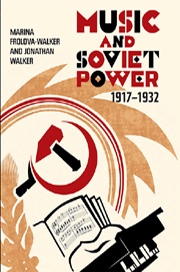Book contents
- Frontmatter
- Contents
- Preface
- Acknowledgements
- Note on transliteration
- Chronology of Political and Musical Events
- October 1917–18: Out of Chaos
- 1919: Depression and Fever
- 1920: Bureaucracy on the Rise
- 1921: Should I stay or should I go?
- 1922: Just Like the Old Days?
- 1923: The Birth of ASM and RAPM
- 1924: ASM in the Ascendant
- 1925: Equilibrium
- 1926: Guests from the West
- 1927: Celebrations
- 1928: At the Crossroads
- 1929: Velikiy perelom – The Great Turning Point
- 1930: RAPM's Glorious Year?
- 1931: RAPM's Fortunes Turning
- 1932: The Rules Change
- Key to Acronyms and Institutional Bodies
- Glossary of Names
- Bibliography
- Index
1923: The Birth of ASM and RAPM
Published online by Cambridge University Press: 05 April 2013
- Frontmatter
- Contents
- Preface
- Acknowledgements
- Note on transliteration
- Chronology of Political and Musical Events
- October 1917–18: Out of Chaos
- 1919: Depression and Fever
- 1920: Bureaucracy on the Rise
- 1921: Should I stay or should I go?
- 1922: Just Like the Old Days?
- 1923: The Birth of ASM and RAPM
- 1924: ASM in the Ascendant
- 1925: Equilibrium
- 1926: Guests from the West
- 1927: Celebrations
- 1928: At the Crossroads
- 1929: Velikiy perelom – The Great Turning Point
- 1930: RAPM's Glorious Year?
- 1931: RAPM's Fortunes Turning
- 1932: The Rules Change
- Key to Acronyms and Institutional Bodies
- Glossary of Names
- Bibliography
- Index
Summary
Accounts of Soviet musical life in the 1920s generally select and locate events within the scheme of a conflict between two factions: namely, ASM (the Association for Contemporary Music) and RAPM (the Russian Association of Proletarian Musicians). We intend to show that many significant events fall outside such a scheme; but the conflict itself certainly deserves attention, and above all in our discussion of 1923, the year that saw the emergence of both groups. The moments of their births were, indeed, connected by a remarkable and symptomatic story that sheds much light on the power struggles of the NEP period, even though its reconstruction is inevitably dependent on an array of fragmentary and partial sources.
To maintain itself and to wield influence, any such association needed a secure financial base, and preferably some degree of support from a well-established state institution. For music, the key institution was the Music Section of the State Publishing House (Muzsektor Gosizdata). From its inception in 1918 up to this point, the head of Muzsektor was Pavel Lamm, a distinguished music scholar and editor of German extraction, and also a close friend of Myaskovsky. From pre-Revolutionary times, the Lamm–Myaskovsky circle had been a pillar of Moscow's musical life, and had attracted the enthusiastic participation of young composers, not least for the opportunity to play through Lamm's own eight-hand arrangements of major new orchestral works. During Lamm's tenure at Muzsektor, Myaskovsky played a leading role in the jury that determined which musical works were passed for publication.
- Type
- Chapter
- Information
- Music and Soviet Power, 1917–1932 , pp. 85 - 99Publisher: Boydell & BrewerPrint publication year: 2012



